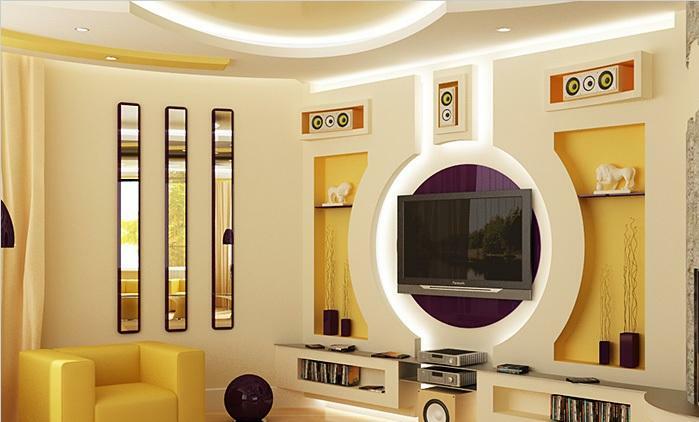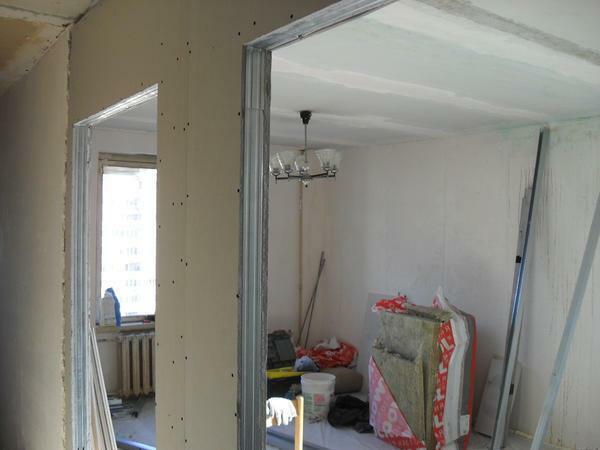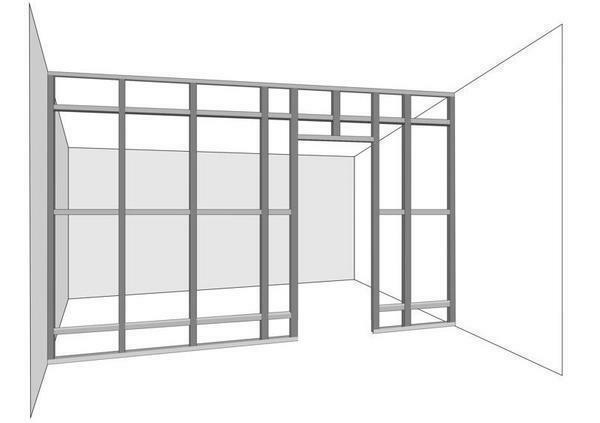Contents
- 1 Selecting glue or mortar
- 2 Slabs or block
- 3 Mounting technology for gypsum blocks
- 4 Door apertures in partitions of their slabs
Today there is a wide variety of building materials from which you can make quality and durable partitions in an apartment or a private house. But often the choice of a particular depends on the type of construction of the structure. If the floor is a reinforced concrete slab between the floors, then making the interior partitions is as important as possible.
The most optimal of which to make interior partitions and light are gypsum board constructions, but today there is no small interest in such masonry material as a gypsum block and foam block. But the various blocks being a new means for quickly and inexpensively erecting partitions in an apartment or a private house, nuances arise during work that must be observed without fail. First of all, let's look at how to put gypsum blocks on a solution.

Types of slabs
Select adhesive or solution
First of all, find out what solution is required for laying gypsum blocks. If there is not enough money for a special acrylic adhesive on a gypsum base, since it is quite expensive, you can use ordinary glue for tile or cement mortar in a ratio of 1: 3 and adding PVA glue to it. With thorough mixing, a very elastic and finely dispersed mixture is obtained, which is easily spread with a spatula and the excess is squeezed out when the unit is put in place. It is much easier to work with a solution, because its setting speed is much less than gypsum glue, which can be used only for the first 60 minutes.

Adhesive for gypsum boards
Often the question arises: "How to put gypsum blocks on glue?", When there is a need to build a septum. In fact, glue is the best tool for erecting partitions from gypsum blocks. It quickly freezes, which allows for a single day to complete the installation with all necessary communications. And after an hour the surface can be easily cleaned by any mechanical method, but this is usually not required if pogo-slabs are used.
Slabs or block
Before considering the technology of partitioning, you should determine the type of material and their advantages. Gypsum block wall is, as a rule, perfectly straight from all sides parallelepiped from a mixture of gypsum, cement and plasticizer. Good geometric parameters for each product are acquired through production technology without the use of high temperatures, as, for example, in the production of foam gas-silicate blocks. But at the same time, the gypsum blocks have better indicators of heat conductivity and strength. High thermal insulation properties of the material have been achieved through the use of sawdust, they also strengthen the structure of the block.
Good strength indicators made it possible to produce pile-and-mortar plates, that is, blocks with a thickness of 8-10 cm and dimensions of 66.7 x 50 cm with a groove and a crest for joining with each other during installation. This is the main difference between slabs and blocks. The gypsum grooves are perfectly flat on both sides and during the installation process the probability of curvature from the level even by a millimeter is low.
If you compare the price parameters, the masonry of the partitions from the pierreplots will be somewhat more expensive, because their value is higher than the blocks. But you can not miss the benefits of working with them. The comb safely enters the groove and at the same time forms a qualitative connection of all the blocks among themselves without the slightest deviation in any planes.

Ideal laying of the
pile-and-tile slabs The masonry of the gypsum blocks is cheaper, but more glue mix is required. It is more difficult to exhibit on planes, which is fraught with curvature and distortions. The main thing is that the technology adheres to the levels, that's why the wall from the block turns out even and high-quality. But you should take into account the advantage - the wall of gypsum blocks, as a rule, is thicker and has better characteristics of strength and sound insulation. As for the weight, of course, it is heavier, therefore, as an alternative, hollow gypsum blocks can be used.
The masonry of blocks in the private house should be made with solid boards. Because for country houses is typical the appearance in the walls of parasitic insects and mice, which can not only bring ecological troubles, but also destroy the walls themselves.
assembly technology for hydraulic assemblies There are several technologies for laying gypsum blocks. Someone prefers to use glue, but somebody has a solution. You can really use both methods, but only certain conditions must be fulfilled. Before we begin to consider how to put gypsum blocks on this or that other means, you should familiarize yourself with the general technology of performing the full complex of works.
For a good example, how to put gipobloki photo can be seen below.
Interior partitions of pazogrebnevyh plates should be smooth and durable. And to achieve this, it is necessary to comply with the installation technology.

Laying of plates in a dry room
To assemble the partition wall was of high quality, it is necessary to let the blocks get used to the temperature at which it will fit into place. To do this, all the material is recommended to be brought into the room and given at least 1 day of addiction. The block, due to the filler in the form of sawdust and plasticizer, slightly widens with increasing temperature, taking the final form. Compliance with this condition will eliminate the possibility of cracks on the next day after the installation of the blocks.
The first step is to mark up the partitioning site. Here you can use both a regular roulette, a plumb line and a long level, and a laser device. When performing large-scale works, it is expedient and much more expedient to use the laser level. Well, at home, when there is nowhere and no reason to hurry, you can do without the usual tools. Pazogrebnevaya septum, as a rule, is perfectly smooth from all sides, so no plaster or plasterboard coating is required. Unless, of course, additional warming is required. Therefore, when marking the master, this is taken into account and the distance equal to the thickness of the additional finishing deviates from the original line.


Surface preparation
Mounting of the parapets should only be carried out on a qualitative and conscientiously prepared surface. Therefore, using a broom, brush and other tools, carefully sweep the place of installation of the partition. Also, the installation of partitions from pierreplant plates provides a perfectly flat surface. To obtain this, a mechanically cleaned place is treated with concrete contact( acrylic or any other primer for concrete).This can be done in two layers for better adhesion of the leveling layer.
If the house has reinforced concrete floors, this does not mean that the surface is perfectly flat. To correctly place the gypsum blocks, the deviations should not exceed more than 3 mm, otherwise the surface must be leveled.
If the leveling layer is very thin, then a self-leveling mixture can be used. To do this, install something like a formwork and pour the solution with a special roller with needles to roll the solution evenly over the entire plane. If the baffle plate is installed on an excessively curved surface, then it can be leveled using a semi-dry screed. To do this, in a ratio of 1: 3, the cement mixes 500 grades and sifted through fine sieve sand. Further, water is added, and the solution is mixed until a uniformly moist( not wet) mixture is obtained. Further, the process should not be described, because it is not from this topic. After leveling with a semi-dry rod and completely drying it( 1-2 days), the surface must be treated again with earth( concrete contact).Everything, the surface is ready to proceed with the installation.

Alignment and marking of the sole
It is necessary to make sure that the partition from the piercement plates does not vibrate and does not resonate, thereby increasing the soundproofing properties of the room. For this, it is necessary to provide a damper layer at the place of contact with the floor and the wall. To do this, you can apply a tape from the cork substrate width of 15 cm and a thickness of 4 mm. It will compensate for all possible fluctuations and the degree of expansion of the partition when the temperature changes. The tape can be mounted on the same adhesive as the plates themselves. For this, a certain amount of it is diluted, it is better not to mix it with water, because it will still become unusable before the laying of blocks. And with a spatula, a thin layer is smeared onto the prepared surface and the ribbon is carefully rolled out and pressed against the base. Allow the glue to set at least 1 hour.

Preparation of walls
All the damping layer is ready, it is possible to install slabs for padding.
For better orientation relative to the level, you can use physical slats, that is, with dowels to attach the guides to the wall and the floor on both sides of the partition. This will minimize the possibility of deviation during installation.
In the next step, we'll look at how to properly place gypsum blocks. For a more reliable fastening of the plates among themselves and a better geometry of the plate wall, it is necessary to lay a groove upwards. To do this, using the usual manual hacksaw, the lower ridge is carefully removed. Here it is important to leave the surface perfectly flat without protrusions, so that it densely lies on the damper substrate.
Mortar for laying gypsum blocks or glue should be spread with a spatula immediately on the tape, and then on the blocks. It is not required much, because at docking the surpluses will still be squeezed out by the weight of the plate.
Shrinkage of each plate is carried out using a hammer with a rubber lining or through a bar until the surfaces come into contact completely.
The laying of the slabs should be done in staggered order or with a displacement of each row relative to each other not less than 1/3 of its width. This will make the partition very strong and resistant to any impacts.

Plate fastening to the wall
The device of the parapet partitions necessarily includes its fastening to the wall and floor using perforated corners. To the blocks it can be fixed with regular wood screws, to the floor and walls using dowels or anchors. Fasteners should be performed at least once through a row or a block in a row.
The video below will be an excellent instruction and an update to the article.
Door apertures in the partitions of their
slabs The installation of the partition from the slabs can not do without door or window openings. In this case, if the height of the partition is no more than 3 m and only 1 row of plates will fit above the opening up to 80 cm wide, then the jumpers can be used. It is enough from wooden blocks to make a small half-frame with a width of an aperture and to fix it with screws to plates. Next, the next row of blocks with periodic quality control of surfaces is laid down with the help of a level.
Door aperture in the partition of the
PGP. Making the partition walls, the installation of it must be done qualitatively, therefore the remaining space between the ceiling and the plates is qualitatively frosted with mounting foam. After drying, small dimples and foam are leveled with the same glue and after 1 hour the septum is ready for further finishing.


